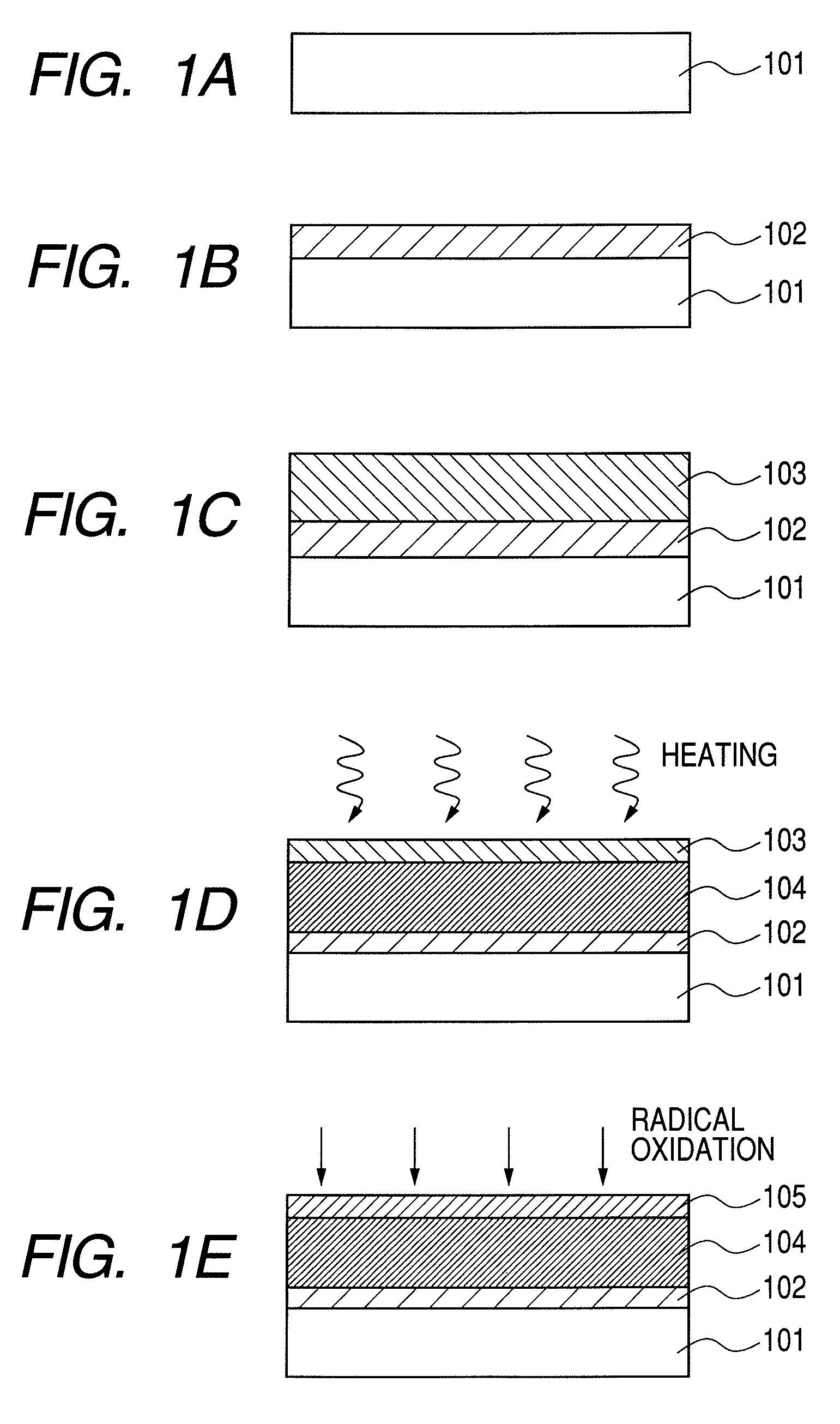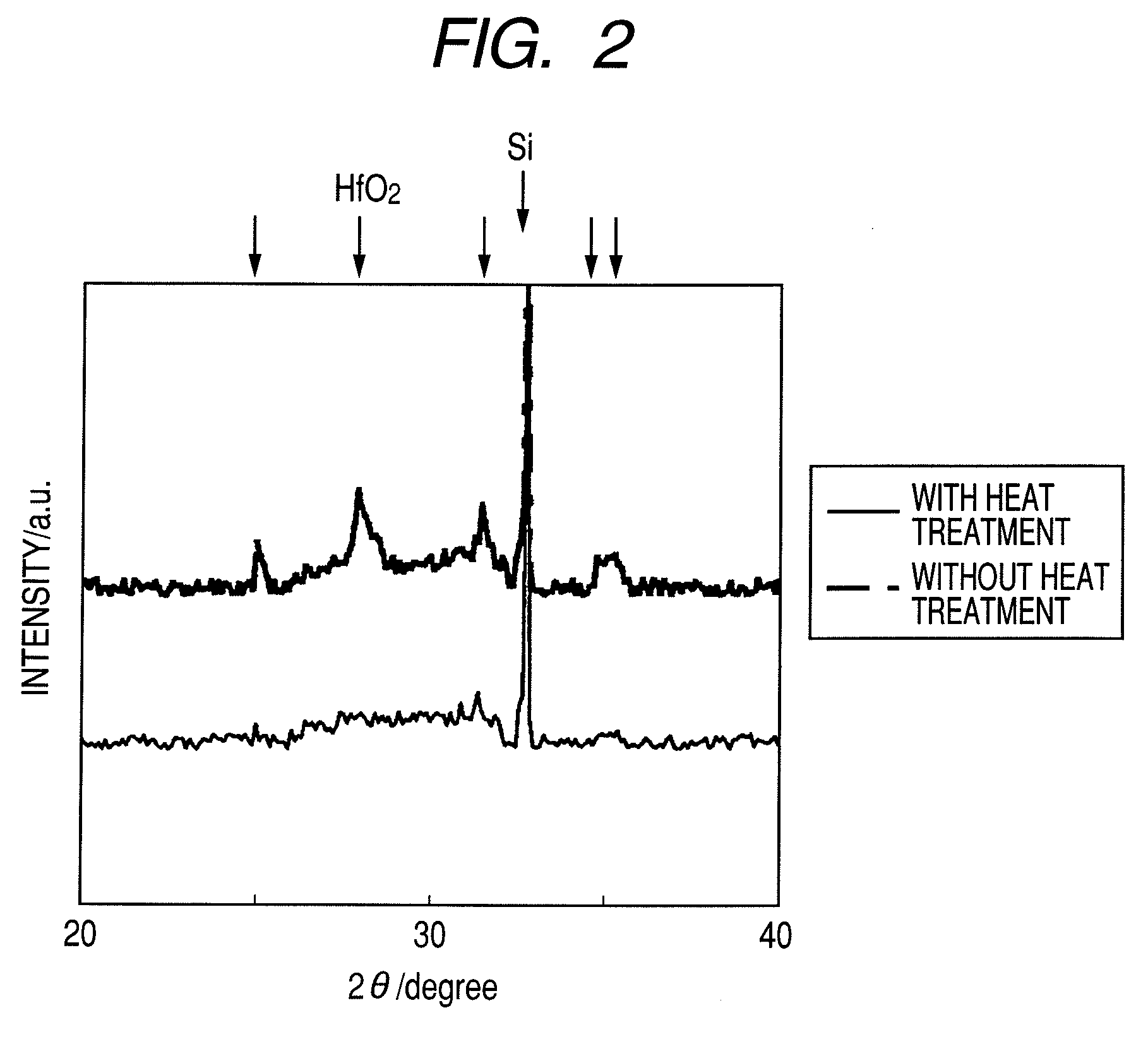Process for forming dielectric films
a dielectric film and film technology, applied in the field of forming dielectric films, can solve the problems of reducing the capacitance increasing power consumption disadvantageously, and reducing the length of gate dielectric films, so as to achieve high permittivity, high productivity, and precise controllability.
- Summary
- Abstract
- Description
- Claims
- Application Information
AI Technical Summary
Benefits of technology
Problems solved by technology
Method used
Image
Examples
example 1-1
[0073]The process of this Example was conducted as illustrated in FIGS. 1A to 1E. Silicon substrate 101 was a p-type monocrystalline silicon substrate of 200 mm diameter.
[0074]Firstly, the surface of substrate 101 was cleaned by RCA cleaning to eliminate impurities and a native oxide film.
[0075]Next, substrate 101 was transferred to a high-speed thermal oxidation equipment and was thermally oxidized in an oxygen atmosphere at 1000° C. to form silicon dioxide film 102 of 2 nm thick on the surface layer of substrate 101.
[0076]Subsequently, substrate 101 having silicon dioxide film 102 was transferred into an RF magnetron type sputtering equipment not shown in the drawing. The target of the sputtering equipment was constituted of Hf. The sputtering equipment holding the substrate inside was evacuated to a vacuum of 2.6×10−3 Pa. Substrate 101 was heated by a heating means and was kept at 300° C. Thus oxygen and moisture which can oxidize the metal film in the deposition of the metal fil...
example 1-2
[0082]The process of this Example was conducted as illustrated in FIGS. 1A to 1E. Silicon substrate 101 used was a p-type monocrystalline silicon substrate of 200 mm diameter.
[0083]The substrate was treated through the steps to the radical oxidation in the same manner as in Example 1-1.
[0084]In the next step of nitridation, substrate 101 having films 102, 104, 105 was transferred into a plasma equipment which generates nitrogen radicals by surface-wave plasma.
[0085]The plasma equipment was evacuated, and N2 gas was introduced into the plasma equipment at a flow rate of 200 sccm. The pressure inside the plasma equipment was kept at 26 Pa. In this step, the temperature of substrate 101 was kept at 200° C. by heater incorporated in a substrate-supporting stage for heating the substrate. A microwave of 2.45 GHz was emitted from an antenna and was introduced into the plasma equipment through a dielectric wall for keeping the vacuum in the equipment to generate surface-wave plasma. With t...
example 1-3
[0088]The process of this Example was conducted according to the embodiment illustrated in FIGS. 1A to 1E. Silicon substrate used was a P-type monocrystalline silicon substrate of 200 mm diameter.
[0089]In this Example, silicon dioxide film 102 in the surface layer of substrate 101 had a thickness of 1.6 nm, and metal film 103 was formed by sputtering in a thickness of 1 nm. After the formation of the films, the substrate having the films was treated through the steps to the radical oxidation to prepare a sample in the same manner as in Example 1-1 except that the temperature and time of the heat treatment after formation of the metal film were changed as shown in Table 1 below.
[0090]
TABLE 1HeatingConditionstemperatureHeating time1600° C.60 seconds2700° C.60 seconds3600° C.120 seconds
[0091]The distributions of the elements in the film thickness direction (depth direction) in the insulating film of the test sample piece were measured by RBS. FIGS. 3A to 3C show the measured distribut...
PUM
| Property | Measurement | Unit |
|---|---|---|
| thickness | aaaaa | aaaaa |
| partial pressure | aaaaa | aaaaa |
| temperature | aaaaa | aaaaa |
Abstract
Description
Claims
Application Information
 Login to View More
Login to View More - R&D
- Intellectual Property
- Life Sciences
- Materials
- Tech Scout
- Unparalleled Data Quality
- Higher Quality Content
- 60% Fewer Hallucinations
Browse by: Latest US Patents, China's latest patents, Technical Efficacy Thesaurus, Application Domain, Technology Topic, Popular Technical Reports.
© 2025 PatSnap. All rights reserved.Legal|Privacy policy|Modern Slavery Act Transparency Statement|Sitemap|About US| Contact US: help@patsnap.com



